Electrifying Literature: ELO Conference 2012
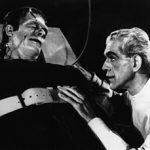
How does the electronic literature community continue to develop? Amaranth Borsuk looks towards the print literature community, and suggests that we adopt a number of its most successful practices.
How does the electronic literature community continue to develop? Amaranth Borsuk looks towards the print literature community, and suggests that we adopt a number of its most successful practices.
This series of short interventions were made at the “Futures of Electronic Literature” discussion at the bi-annual Electronic Literature Organization conference in 2012. Titled “Electrifying Literature: Affordances and Constraints,” the conference took place at West Virginia University in Morgantown on June 20th to June 23rd. The contributors were organized by Stephanie Strickland to offer suggestions on how to improve the organization as it attempts to re-define its mission in a shifting cultural, economic, and technological landscape. Ranging from the concrete to the poetic to the theoretical, the following [insert number] short statements were made by a group of emerging artists, scholars, and practitioners from a variety of disciplines and backgrounds.
(The following comments were delivered as part of the panel “Futures of Electronic Literature” at the 2012 Electronic Literature Organization conference in Morgantown, West Virginia. Audio of this presentation can be found at: *http://harp.njit.edu/~funkhous/chercher/audio/borsuk-amaranth/borsuk-ELO\_1.mp3)*[+gloss1]
I’ll keep my comments brief, but I would like to preface them by giving you a sense of my stake in the future of the ELO, as both a scholar and a practitioner. There are three things I think I need from this organization: first, a community to whom I can direct questions about teaching, writing, and publishing; second, a resource for learning about events and works that might be of interest; and third, a collective of advanced-career scholars who are actively attempting to raise the profile of digital publishing and creative practice so that this work can be “counted” (so to speak) down the line, when it comes to questions of academic advancement.
I think this group has addressed, and will address, some of these concerns, so I’m going to focus on one question that concerns me: that of the ELO’s image in the wider literary and art world. I will be mostly asking questions, only some of which are rhetorical, and I will attempt to make a few provisional suggestions, though I’d rather see what arises from this conversation overall.
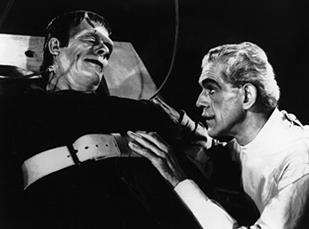
http://en.wikipedia.org/wiki/File:House_of_Frankenstein,_Glenn_Strange,_Boris_Karloff.jpg
If electronic literature is about, as the conference title says, “electrifying literature” itself, as in hooking up electrodes to the body of language and shocking it from an inert state into action, we have a couple of slight problems in that literature isn’t in fact dead matter in need of revivification, nor is it a hysterical patient in need of a cure from romantic malaise or erotic repression (if you believe any of those things, in fact, exist).
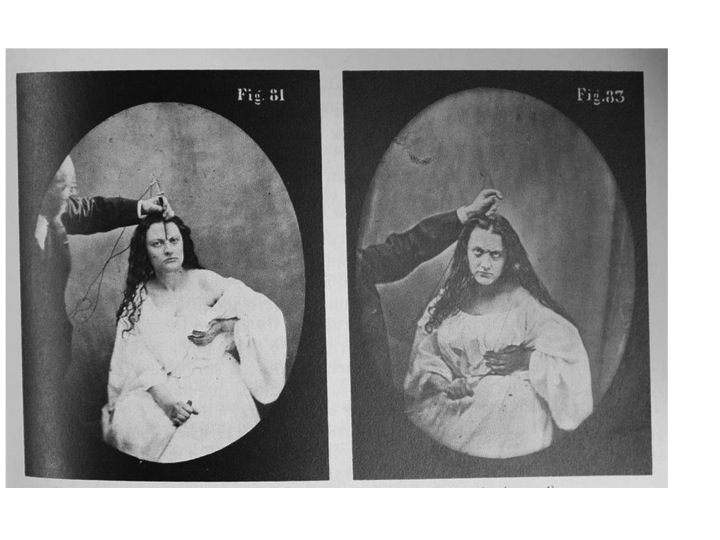
Duchenne (de Boulogne), Guillaume-Benjamin-Amand. Mécanisme de la physionomie humaine. (Paris: J.-B. Bailliere et Fils, 1876) pp. 89, 91. ISSN 1866-4784
http://morbidanatomy.blogspot.com/2010/07/lady-macbeth-expression-induced-with.html http://vlp.mpiwg-berlin.mpg.de/library/data/lit25060/index_html?pn=88&ws=1.5 http://vlp.mpiwg-berlin.mpg.de/library/data/lit25060/index_html?pn=90&ws=1.5
But, more importantly perhaps, given this professed position as electrifiers of literature, and with the literary world at large, and the publishing world as well, concerned with the potential and often-reported death of books (illustrated here by the more utilitarian function of the book object as a pillow),

Sources:http://cutestuff.co/2012/06/sasha-the-puppy-sleeping-on-a-booksasha-the-puppy-sleeping-on-a-book/
Why isn’t the electronic literature organization, whose title conjures up images of words that wear microchips or 8-bit text hacked from various electronic screens, spearheading the conversation about where literature is headed?

http://inglespararolos.wordpress.com/2011/12/01/going-up-consejo-para-verbos-con-up/
If Google is hiring people like Aaron Koblinto do all kinds of great data visualization and social collaboration projects, why aren’t we part of that conversation? And why aren’t these practitioners, whose work does rely on language, although they may not position themselves as working in a literary mode, taking part in our conversation? Are there any talks being presented here over the next few days that consider the sort of large database projects that are happening right now in the design world as a form of electronic literature, and if so, how can we continue to bridge these worlds?

images: Koblin: http://www.aaronkoblin.com/
Projects: http://www.aaronkoblin.com/work.html
My sense is that this is a time when the creative and critical expertise of this group can and should be put to use, and that the ELO has a real opportunity to stake out a space in the terrain of the future of books. We might consider some collective opportunities to advance this organization’s image and make our members central to this ongoing conversation.
If ELO’s mission is to draw attention to exciting and thought provoking works of new media writing through initiatives like the Electronic Literature Collection and Directory, what can we do to stimulate the creation of cutting edge work that will both represent the institution as a whole and benefit the artists and writers involved?
I think that supporting the creation of aesthetically interesting and intellectually engaging work would be a vital step in this process and could be achieved in several ways:
First, through the creation of a major prize to recognize work that is at the forefront of electronic literature and that has broad appeal.
Last year, the New Media Writing Prize was inaugurated at Bournemouth University in England, and I think that an equivalent stateside prize would set up the ELO as a vital arbiter of taste when it comes to digital literature.
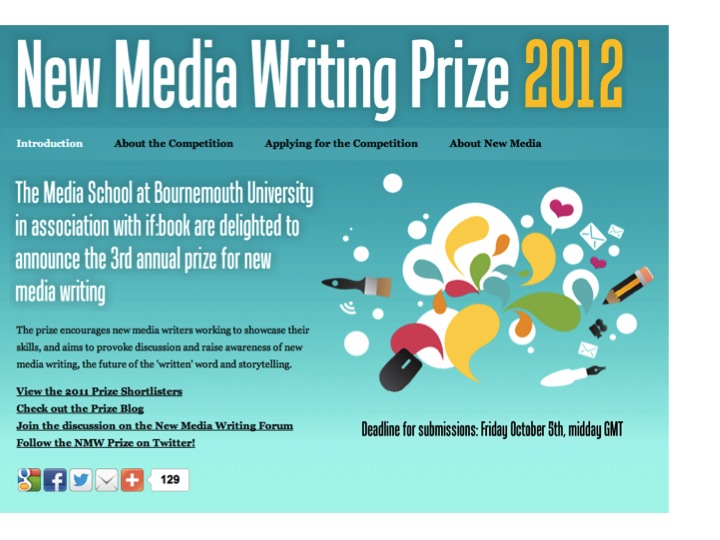
I think it’s wonderful that this year the conference organizers awarded a jury prize internally, and I would love to see an external award with a wide applicant base and multiple categories to both bring outstanding work from outside this group to the attention of its constituents (for inspiration and to broaden the base of potential members) and to establish this group as a tastemaker in the world of new media art.
A second method for establishing the Electronic Literature Organization’s reputation in the field would be through centralizing resources that bring e-lit in front of a larger community, potentially through a web-based journal that serves as a go-to source for influence and inspiration within the electronic literature community and beyond.
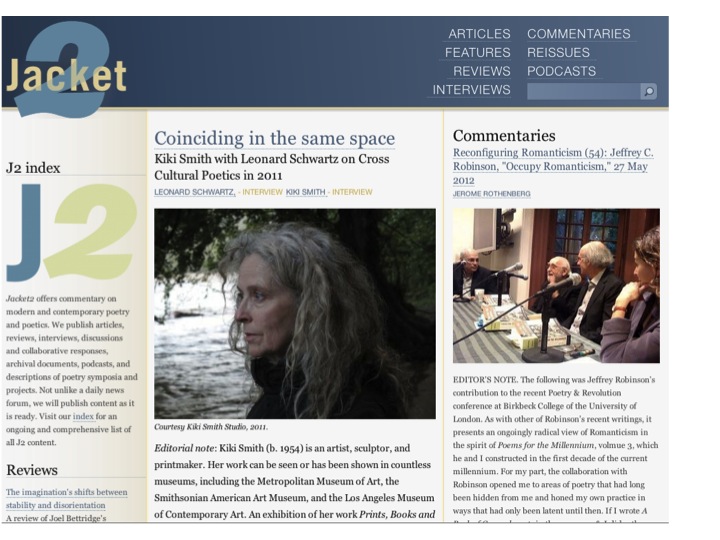
My model for such endeavors are Jacket 2, the reboot of Jacket Magazine, and the Poetry Foundation’s Harriet blog, which are extremely active sites and which provide one-stop shopping for accessible and intellectually rigorous blog posts about the latest news in contemporary poetry. It is possible that the redesign of the ELO website will serve this purpose—that remains to be seen.
Third, through encouraging collaboration and knowledge acquisition by practitioners by funding week-long or multi-day workshops at host institutions across the country in which area writers, artists, coders, and designers get together to share knowledge and to produce a single group-authored work. I imagine a potential host would apply to the ELO for funds to put on an event like this, listing suggested contributors, and then, as thanks for the funding to do so, would offer a follow-up blog post and report on the outcomes of this gathering. The benefits of this jam session / hackathon for those involved would be knowledge acquisition, connection within the community (here embodied by the spirit of experimentation and innovation that has permeated gatherings of the Oulipo from 1960 to the present), and potentially the opportunity to either fail big or create an interesting new work of electronic literature, broadening the membership base and the database.
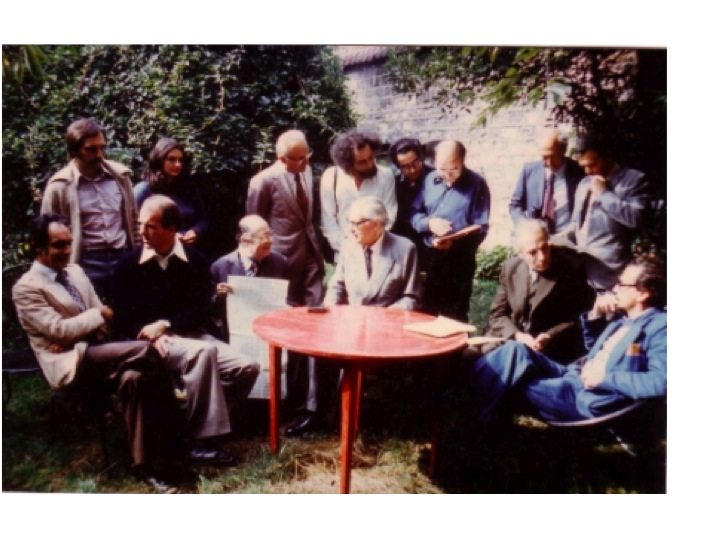
http://www.bibliotheque-rennesmetropole.fr/typo3temp/pics/6456a5e83b.jpg or http://www.oulipo.net/oulipiens/docs/photos-de-francois-le-lionnais
Alternative image: http://wewhoareabouttodie.com/2010/04/14/five-oulipo-related-constraints-with-links-some-new-ones-too-for-all-you-oulipian-veterans/ (a doctored version of this picture)
These ideas are based on models established by other organizations, and may be misguided, but I hope you will consider them as potential avenues for boosting the reputation of the ELO, which I think deserves not only to take part in, but to lead this conversation. By supporting and promoting excellent work and boosting its public presence, the ELO can continue to fulfill its mission “to foster and promote the reading, writing, teaching, and understanding of literature as it develops and persists in a changing digital environment.” Thanks for your time.
Amaranth Borsuk is currently an Assistant Professor in Interdisciplinary Arts and Sciences at the University of Washington, Bothell. She recently served as Mellon Postdoctoral Fellow in the Humanities at MIT and holds a Ph.D. in Literature and Creative Writing from the University of Southern California. She is the author of Handiwork (Slope Editions, 2012), selected by Paul Hoover for the Slope Books Prize, and, with Brad Bouse, of Between Page and Screen (Siglio Press, 2012), a book of augmented-reality poems. Her essays, reviews, poems, and translations have appeared in print and online. For more information, visit amaranthborsuk.com.
⏴Marginnote gloss2⏴E-Lit Futures 2012 Forum: Next in Line Donato
— Dibs (Feb 2014) ↩
Cite this essay
Borsuk, Amaranth. "Electrifying Literature: ELO Conference 2012" Electronic Book Review, 1 March 2014, https://electronicbookreview.com/publications/electrifying-literature-elo-conference-2012/